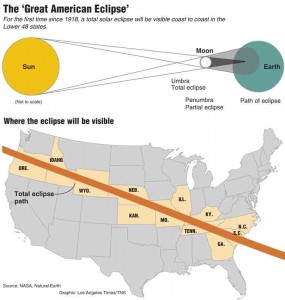The path of totality
Here’s a phrase that’s making the rounds: “path of totality.”
The phrase refers to the geographic ribbon on the earth’s surface where the moon entirely covers the sun during a solar eclipse. There’s a lot of buzz about it because of the upcoming “Great American Eclipse.” This will occur on Aug. 21 (mainland time). The path of totality will extend between Oregon and South Carolina like a seat belt running diagonally across the nation.
Some of my pals were inking their plans for the event two or three years ago.
One such guy wasn’t granted the necessary vacation time by his boss. The guy is going to do a Johnny Paycheck (“Take this job and shove it”) and ghost from his job when the time comes. Hey, problem solved.
I know two other guys who bought campers so they can make long road trips out of the event. They’re going to keep a close eye on weather forecasts so they can position themselves accordingly. Other people will be staying in hotel rooms and hoping their skies aren’t cloudy when the big moment finally arrives.
Astronomy magazines, tourism organizations, and various manufacturers of astronomical gear are on the bandwagon.
Likewise, news reports in the general press are circulating along with stern warnings that you shouldn’t look directly at the sun without appropriate filters. Me, I wonder how many people were planning on staring at the sun but who reconsidered their plans after reading newspaper articles that advised against it.
If I were to make one point about this gig, it would be this: It doesn’t take a major event, such as an eclipse, to enjoy the skies. The popular emphasis on newsworthy events is understandable, but the celestial show is always intriguing.
However, many people don’t give it any thought just as many people don’t give their health a thought, up until some event compels attention. The wonder of the ordinary is not an outlook with broad appeal.
Anyway, ads for sorts of items for eclipse viewing have passed under my nose, but I haven’t tried any of the products so I can’t come up with any recommendations.
Now that we’re on the topic, though, there is something with a celestial orientation that I highly recommend, not for the eclipse, but for general use in bare-eye stargazing. The fancy name for such devices is “planisphere.” It’s basically a star map with a rotating dial that accounts for the user’s latitude, time of day, and time of year. The brand I recommend is a plastic device called “The Night Sky.” It’s made by the David Chandler Company. It shows the most prominent stars and constellations. A few other highlights (e.g. galaxies and other stuff beyond bare-eye range) are also charted. These planispheres come in two sizes, large and small. I suggest the large. It’s roughly the size of a sheet of typing paper.
Various models of “The Night Sky” are made for various latitudes. As far as I know, Saipan’s latitude (15 degrees north) does not fall within any of these models. There is, however, a model that covers the 20-degree to 30-degree band of north latitudes. That’s close enough to be useful. After all, we’re talking about basic orientation here, not precision moon shots.
The street prices for these things are roughly $10 to $12. I’ve probably bought a dozen of them over the years. I’ve given a few away. I’ve lost a few, too. However, despite my best efforts I have yet to destroy one of them, although I’m just bright enough, or at least lucky enough, not to have left one of these thin plastic disks inside a hot car.
The manager of a well-stocked telescope store once told me that he gets an uptick in customer inquiries whenever there’s a big astronomical event in the news, but, outside of the few people whose attention really gets hooked by the gig, things quickly subside after the event. I think the paradox is that the big events are often used to attract attention and business, but confining the field to an occasionally dramatic spectacle really overlooks its strongest appeal.
After all, from what I’ve seen, there is nothing mundane about the ordinary, and there is nothing as chaotic as that which gave birth to order. Do I understand it? Probably not. But, then again, I don’t have to. For me, it’s just enough to look.




























